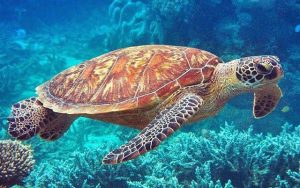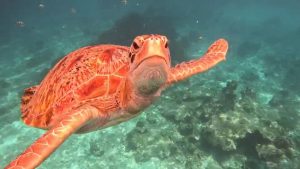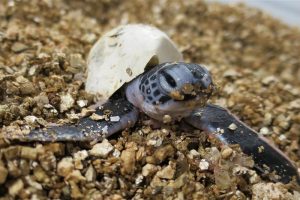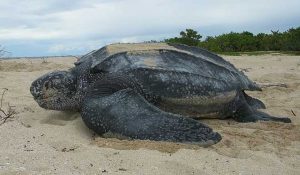Sea Turtles:
They are air-breathing reptiles found in seas around the world in the tropics and subtropics.

Sea turtles have a shell that consists of an upper and lower body. Except for the leather-back turtle. Shells of various sea turtles They are covered in hard scales, known as scales. The number of these scales is actually a good way to identify different sea turtles.
This animal comes in many shapes and sizes. Leather-back turtles grow to very large sizes. Some specimens have been recorded as weighing up to 1,300 pounds. There is also the Olive Riddle sea turtle, which normally never grows to more than 100 pounds.
It is a migratory animal that travels across the seas in its life and has a lifespan of about 100 years. Sea turtles do not have teeth. But years of evolution have seen their jaws evolve into beak-like shapes that help them eat prey.
Although sea turtles may appear to have no ears, their eardrums are actually there but covered with skin. This allows them to hear very well at low frequencies. These reptiles have an excellent sense of smell and can see very well underwater. On the contrary When they are on land and out of water, sea turtles are actually nearsighted.
Sea turtles have large front flippers and very slender bodies that help them swim through the water with ease. Although sea turtles spend most of their time at sea, But their connection to the land remains.
The reason is that female sea turtles come ashore every year to lay their eggs in the sand. This is why the life of all sea turtles begins on land.

This is why the majority of sea turtle research is done on female sea turtles. It is the easiest way to find them and study the adult females and their hatchling.
Sea turtles are amazing reptiles that live in our oceans. Here is some information about them:
Physical characteristics:
Sea turtles have a streamlined body plan that helps them swim efficiently.
Different from other turtles They cannot retract their heads and limbs back into their shells for protection.
Leatherback sea turtles are known to be the largest sea turtles. They can be 1.4 to 1.8 meters (4.6 to 5.9 feet) long and weigh between 300 and 640 kilograms (661 and 1,411 pounds).
Other sea turtles, such as green turtles, are smaller. They range in length from 60 centimeters (2 feet) (the smallest Kemp’s Ridley) to 120 centimeters (3.9 feet).

Sexual dimorphism:
Adult male and female sea turtles are generally the same size.
However, you can tell them apart by the length of their tails. Males have longer tails and an opening near the base. Females have a shorter tail and an opening near the base. Hatched turtles and adult turtles have no difference in sexual behavior. Makes it impossible to determine gender by sight
Conservation status:
Sea turtles face threats such as by-products and habitat loss. Climate change and pollution all sea turtles. All but sea turtles are listed as globally threatened or endangered on the IUCN Threatened Species List.
in United States waters Six of the seven species are listed as endangered and/or threatened under the Endangered Species Act12.
These ancient sailors played an important role in the marine ecosystem. And efforts to protect them are essential to maintaining the health of our oceans.
– Sea turtles have amazing memory abilities. No matter how far a sea turtle travels, Eventually, they will return to lay eggs on the same beach where they hatched.
– During their life, sea turtles will travel in the sea and the ocean is thousands of kilometers long.
– The longest journey recorded is 20,921 kilometers from Indonesia to
west coast of america
– The gender of baby turtles depends on the temperature in the turtle hatchery.
:- If the temperature is lower than 28 degrees Celsius, more males will hatch.
:- If the temperature is higher than 32 degrees Celsius, more females will hatch.
-Sea turtles are different from land turtles. Sea turtles cannot retract their heads and legs back into their shells.
The Leatherback Turtle:
The leatherback turtle’s scientific name is Dermochelys coriacea and is classified as a reptile. It’s a sea turtle. Adults measure 1.5 to 2.5 meters and weigh 800 to 900 kilograms. They are the largest sea turtles in the world!

Tortoiseshell leather It looks like a leather covering. It’s different from other types of turtles that have hard shells. The shape of the feet is paddle-shaped. for use in moving in water The large head cannot shrink back into the shell. And the back shell has 7 longitudinal ridges, similar to a star fruit, which is the origin of the name ‘leather turtle’.
Leatherback turtles live underwater for most of their lives. The main food is jellyfish. and can dive to a depth of 1,280 meters. They breed and lay eggs only on land near beaches. Female leatherback turtles will lay approximately 66 to 104 eggs per hole, depending on age, weather and environmental conditions of the nesting beach. The beach must have the appropriate characteristics, that is, have deep water levels. and there is a steep slope leading to the beach.
In Thailand, leatherback turtles have been found to lay their eggs only on beaches on the Andaman coast in western Thailand, Phang Nga province, Phuket and the Trutao archipelago.
Leatherback turtle eggs take approximately 60 to 70 days to hatch. And only 85 percent hatch to hatch. During this time, the temperature in the egg crater is an important factor in determining the gender of the baby turtles. In general, the proportion of female turtles is higher. When the temperature in the hatch increases
When the eggs hatch The baby turtles will remain in the incubator for another 1 to 2 days, waiting for the remaining eggs to hatch. They then spent the night crawling out of the hole together, heading towards the sea. To face the new world
Because baby leatherback turtles and other sea turtles They have a low survival rate in the wild. The number of sea turtles is therefore rapidly decreasing. coupled with problems with fishing equipment, trawlers, and the development of beaches as tourist attractions Changing the natural conditions of the beach This may result in loss of spawning grounds. As a result, eggs in sea turtle nests have decreased significantly. Currently, it has been found that sea turtle nesting statistics have decreased more than five times, from 2,500 nests to only 300 nests to 400 nests per year over the past 50 years. In addition, the problem of marine garbage is also a threatening factor causing the number of sea turtles to decline. More than 500 sea turtles have washed ashore in the past 10 years.
The leatherback turtle is currently classified as having a global conservation status: Vulnerable (VU) by the IUCN, and the conservation status in Thailand is ‘Vulnerable’ (VU).
Surprisingly, leatherback turtles eat jellyfish. And they eat a lot of jellyfish every day. To keep them healthy
Leatherback turtles are known to eat approximately 200 kilograms of jellyfish per day. and their insane appetites Instead, it plays an important role in creating ecological balance.
Migration of leatherback turtles They migrate across the ocean and as they eat large quantities of jellyfish. This makes them the top jellyfish hunters in the sea.
Other types of sea turtles They also help eat jellyfish such as loggerhead turtles and green turtles.
Bibliography
– https://th.wikipedia.org/wiki/Leatherback turtle
– https://www.khaosod.co.th/around-thailand/news_2011031
– https://www.thairath.co.th/content/1455310
– https://km.dmcr.go.th/th/c_258/d_19105
